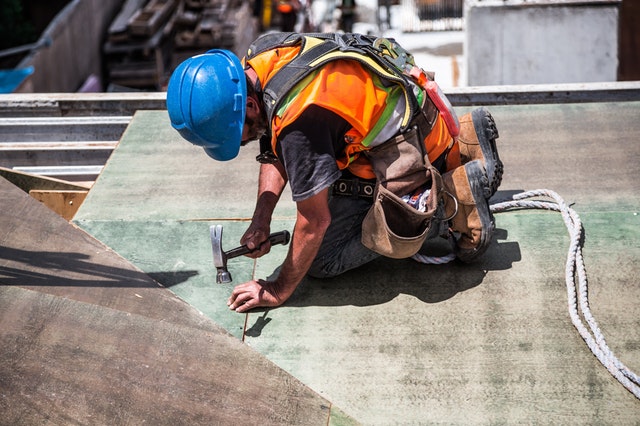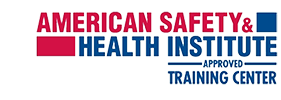
Accidents can occur at virtually any jobsite. Accidents in science labs are not out of the ordinary and sometimes there are even accidents in offices. Then there’s construction. The construction industry has one of the highest rates of work-related accidents and injuries and accounts for about 20 percent of workplace fatalities. To help lower this number, we’re sharing how to prevent and treat the most common causes of accidents at construction sites. With basic CPR training and AED training you can help protect your job site from emergency situations.
Preventing and Treating Falls at Construction Sites
Construction jobs often involve working on top of scaffolding, roofs, or using ladders, and because of this, falls from high places is the leading cause of injury and death at a construction site. However, many of these falls can be prevented with the right safety equipment and training. OSHA regulations require that any worker is six feet or more above lower levels (or the ground) needs to have fall protection gear and the right ladder, scaffold, or other safety gear to minimize risk.
Preventing falls:
- Make sure any harnesses or fall arrest systems fit correctly and are inspected for safe use.
- Never use a ladder on uneven ground.
- Guardrails need to be properly installed on all scaffolds and areas on jobsites with unprotected sides.
- Clearly mark open areas on high spaces, like skylights, holes, or gaps with caution tape.
First Aid falls from high distances:
- Call 911 immediately.
- Do not move them, as this may cause additional injury.
- Check for consciousness, signs of breathing and a pulse. If there isn’t a heartbeat, begin CPR.
- Stop any bleeding by applying gentle pressure using a sterile bandage or clean cloth.
- Don’t try to set a broken bone.
- Treat for shock by providing a blanket or cover if the person is cold, making sure they are laying down and elevating the legs if possible.
- Keep the person calm and assure them that help is on the way.
Falling Objects at a Construction Site
Not only are people at risk of falling, but equipment being used on scaffolding, ladders, and rooftops can fall and strike someone on the jobsite. “Struck by” accidents are the second leading cause of injury at a jobsite. For example, a hammer resting on a ladder can fall if the ladder is bumped, or roofing materials may slide down a slope, and those items can cause serious injury if they hit someone on a lower level, causing serious head trauma.
Prevent injury from falling objects:
- Always wear proper safety equipment, including hardhats.
- Communicate to those on the lower levels when objects are being transported overhead, such as by a crane.
- Use debris nets to catch objects that may fall.
- Set up barricades around openings to prevent objects from falling through holes.
- Use tethered tools for lightweight objects that have built-in connection points to a lanyard or toolbelt.
- Keep tools and supplies in an appropriate receptacle when not in use, rather than just setting them on a ledge or resting on the scaffolding where they may fall or be kicked.
Treating injury from falling objects
- Call 911 immediately when these signs are present:
- bleeding from ears or nose
- severe head bleeding
- loss of consciousness
- confusion, slurred speech
- unequal pupil size
- Watch for changes in breathing and alertness
- Help the victim lie down with their head and shoulders slightly elevated if possible, avoid moving the person’s neck to prevent further injury.
- Stop any bleeding with a sterile gauze or clean cloth but avoid direct pressure if you suspect the skull may be fractured.
Preventing and Treating Lacerations at the Construction Site
Construction workers often use sharp tools to cut through various objects, including concrete, wood, and metal. While cuts and lacerations don’t cause the serious injuries or fatalities that falls or falling objects cause, they are prevalent at construction sites, and a leading cause of hospital trips and workman’s compensation claims.
Prevent cuts and lacerations:
- Wear gloves when working with power tools and sharp objects.
- Cover sharp edges, such as rebar.
- Retract or cover blades when not being used
- Use equipment that is in good condition, avoid using dull blades.
First aid for cuts and lacerations:
- Call 911 for severe injury and treat for shock if necessary.
- Do not attempt to apply a tourniquet unless the injury is life-threatening. If a tourniquet is needed due to severe blood loss, place it two inches above the wound and never on a joint.
- Use sterile gauze or a clean cloth and apply gentle pressure to stop the bleeding. If bleeding is heavy, muscle or fat tissue is visible, or the wound is gaping, seek medical attention immediately.
- Clean the wound with water and remove any dirt or debris from the area.
- Apply an antibiotic cream to the area and cover with a clean bandage or sterile gauze.
Overexertion and Heat Stroke on Construction Sites
Construction workers are often working outside in harsh conditions, leading to weather-related health emergencies, including heat exhaustion and hypothermia. Signs of heat stress include headache, dizziness, nausea, weakness, and confusion, and in more serious cases of heat stroke, the signs include high body temperature, profuse sweating, or hot, dry skin. With hypothermia, where the body’s core temperature has dropped, signs include poor coordination, blue lips and fingertips, disorientation, irritability, and slow breathing.
Preventing Heat Stroke:
- Wear light, loose clothing.
- Drink plenty of water, at least one pint per hour.
- Take frequent breaks in shady or air-conditioned areas.
- Be mindful of wearing waterproof clothing that doesn’t breathe.
- Notice the signs of heat fatigue and treat them before symptoms worsen.
Treating Heat Stroke
- Call 911 immediately if a worker is showing signs of heat stroke.
- Move the worker to a cool, shady area.
- Loosen the person’s clothing.
- Try to have a fan on the worker.
- Apply cool water or ice packs to his or her skin.
Preventing Hypothermia
- Dress in layers, choosing an inner layer that wicks moisture away from the skin and an outer layer that repels wind, snow, and rain.
- Protect your hands, feet, and head with gloves, wool socks and waterproof shoes, and a hat.
- Drink plenty of fluids and eat to fuel your body to stay warm.
- Take breaks in warm areas and seek shelter from wind and moisture.
- Move your body to warm your core.
Treating Hypothermia
- Call 911 or take the victim to a hospital.
- Provide warm, dry shelter.
- Keep them awake and monitor their breathing and pulse
- Remove wet clothing and provide warm covers or blankets, taking care to warm the core.
- Give warm, sweet drinks, but only if the person is conscious.
Sign Up for a First Aid Course in Raleigh
Construction accidents and injuries are all too common, but many can be prevented. However, if someone does get injured on the job, having the skills to step in and provide first aid can save their life while you’re waiting on help to arrive. To get certified in both CPR and first aid, sign up for a CPR class at our Raleigh location, or if you’d like to provide on-site first aid training for your team, reach out to us today at 919-639-4848 or fill out our contact form today!



